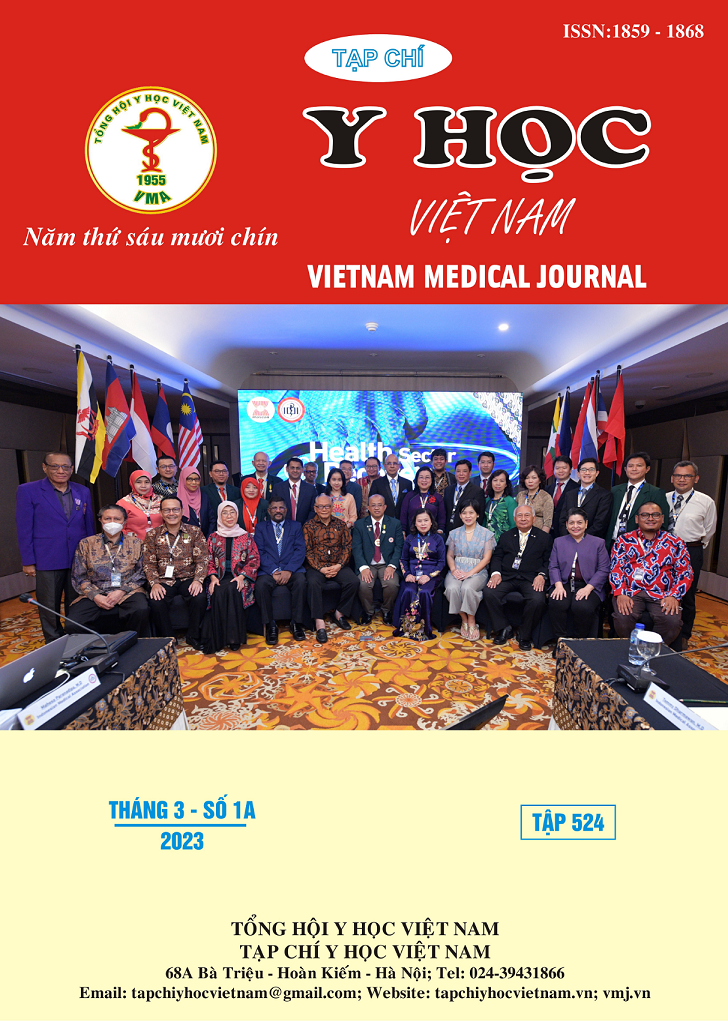RESULTS OF SURGICAL REPAIR FOR INTERRUPTED AORTIC ARCH ASSOCIATED WITH VENTRICULAR SEPTAL DEFECT AT VIETNAM NATIONAL CHILDREN’S HOSPITAL
Main Article Content
Abstract
Interrupted aortic arch (IAA) is a complex congenital heart disease that presents early in the neonatal period with high overall mortality and reoperation rate for the aortic arch and LVOT. Our cohort study aimed to evaluate the results and risk factors of death, LVOT reoperation, and arch reintervention after the biventricular repair of the interrupted aortic arch with ventricular septum defect. All 68 patients in our study underwent surgery to repair the aortic arch. The median age at surgery was 23 days old (interquartile range-IQR:14 days- 42.5 days), and males accounted for 66.2%. The median weight at surgery was 3.3kg (IQR: 3.0-3.6kg). In our study, 57 patients underwent primary surgery, 7 underwent LVOT bypass surgery, and 4 underwent aortic arch repair with banding of the pulmonary artery. The mean follow-up time of the study group was 35.5±29.5 days, Early death after surgery had 10 patients (14.7%) and 01 patient died late. The overall actuarial survival after surgery at hospital discharge, 1 year, 3 years, 5 years, and 10 years were 92.6 %, 84.5%, 82.9%, and 82.9%, respectively. Risk factors for time-related death include preoperative culture blood positive (p= 0.002), prolonged postoperative mechanical ventilation (p<0.001), and IAA type B with remote DORV (p=0.002). 9 patients had resected the fibrous/muscle of the subaortic region and 2 patients were catheter-based dilated for arch restenosis. During the follow-up period, the proportion of patients who did not need to reoperate resulting from LVOT obstruction at the time points of 1 year, 5 years, and 10 years, respectively was 97,6%, 81,7%, 73%, and 73%. The result of biventricular repair of the IAA with VSD in newborns and infants in the National Hospital of Pediatrics is satisfactory. Patients with IAA will require ongoing surveillance with cardiology.
Article Details
Keywords
Interrupted aortic arch, ventricular septum defect, biventricular repair
References
2. Rudolph-Congenital Diseases of the Heart_ Clinical-Physiological Considerations 3rd Edition (2009).pdf.
3. McCrindle BW, Tchervenkov CI, Konstantinov IE, et al. Risk factors associated with mortality and interventions in 472 neonates with interrupted aortic arch: a Congenital Heart Surgeons Society study. J Thorac Cardiovasc Surg. 2005;129(2):343-350. doi:10.1016/ j.jtcvs.2004.10.004
4. Schreiber C, Eicken A, Vogt M, et al. Repair of interrupted aortic arch: results after more than 20 years. Ann Thorac Surg. 2000;70(6):1896-1899; discussion 1899-1900.
5. Fulton JO, Mas C, Brizard CP, Cochrane AD, Karl TR. Does left ventricular outflow tract obstruction influence outcome of interrupted aortic arch repair? Ann Thorac Surg. 1999;67(1):177-181.
6. Hussein A, Iyengar AJ, Jones B, et al. Twenty-three years of single-stage end-to-side anastomosis repair of interrupted aortic arches. J Thorac Cardiovasc Surg. 2010; 139(4):942-947, 949; discussion 948. doi:10.1016/ j.jtcvs.2009.09.069
7. Morales DLS, Scully PT, Braud BE, et al. Interrupted aortic arch repair: aortic arch advancement without a patch minimizes arch reinterventions. Ann Thorac Surg. 2006;82(5):1577-1583; discussion 1583-1584. doi:10.1016/j.athoracsur.2006.05.105
8. Alsoufi B, Schlosser B, McCracken C, et al. Selective management strategy of interrupted aortic arch mitigates left ventricular outflow tract obstruction risk. J Thorac Cardiovasc Surg. 2016;151(2):412-420. doi:10.1016/j.jtcvs.2015.09.060
9. Andrianova EI, Naimo PS, Fricke TA, et al. Outcomes of Interrupted Aortic Arch Repair in Children With Biventricular Circulation. Ann Thorac Surg. 2021;111(6):2050-2058. doi:10.1016/j.athoracsur.2020.05.146


